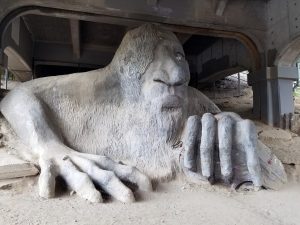The Trunked Horror
In the trunk under the bed—the sepulture of failures past—lurk corpses. The person who sleeps atop this trunked graveyard is an author.
When you venture onto the author path you hear horror stories. You say to yourself fiercely—not me! I will be smarter. I will choose wisely. Forethought will avert tragedy. Dedication will dig me out of any mire. I will master this art in one go. I will publish my first novel.
I can hear the chagrinned, bitter laughter of the veterans out there.

This first book failure is something of a truism in our vocation, though.
A bane—a rite-of-passage that winnows out those who can make a profession of it from those too stubborn to learn—or not stubborn enough.
To go through something as grueling as writing a novel—as vulnerable—is an enterprise of dreams, opening your innermost self to the world, leaving your ego bereft of its normal defenses of a lifetime of accumulated self-worth. To go into this thing where those who have gone before warn that you will find failure—and find it you will. Trunked. Consigning your first love to the soil—a better writer could have saved it—but you were too lacking, weak. That is crushing for most. Those who are not stubborn enough can’t steel themselves to pick up the pen to start over while looking at the miscarriage of their soul.
There are others with the opposite problem—they cannot relinquish their misbegotten, ill-formed idea. They cannot move on. They will not move on. Friends have an intervention—recommend the thing be trunked. The writer will have none of it. They are determined to make that first attempt—that horrendous expenditure of time, effort, and emotional bleeding—work. They are too stubborn.

Many people start writing a novel—a few end up publishing some later work.
I’m stubborn.
I had a plan. When I seriously decided to write a novel I took a hard look at myself—where would I fail? I knew my great weakness—verbosity. Verbosity, pages and pages of it, would condemn my manuscript. Okay—I had to deal with that before I could safely write a novel. I didn’t want to be trunked—I wouldn’t be trunked.
I’d heard rumors of the first-born book curse of death. A screenplay—that was my solution. It’s the antithesis of verbosity—where every word must count and length is rigid. A screenplay was also short enough that if my first died I could face it. I wasn’t naive enough to think that one and done would rid me of my word-monger folly. Three then. Three successes. Two one-hour screenplays to get used to brevity. Then a third story of larger scale bridging two episodes—that would ramp me safely towards novel length while maintaining the constraints I needed to fix my issue.
I did it—and the first screenplay was a failure—at first. So I moved onto the second—that one I managed. Then the two hour screenplay done. Then I went back to the first one hour screenplay and rewrote it—mastered it. Victory over verbosit—and I even salvaged that cursed first work. I was ready for the novel!

I Wasn’t Ready for the Novel
I wrote it half pants, half plot.
It was monster. Even with all I’d learned the length just stretched out. When I did the math I had one book longer than two and a half beefy fantasy books. Right. Okay—I could figure this out. I looked at the beast and went all Procrustean on it—chopped it in three (hey, severing at random segue points worked for The Lord of the Rings). Then I worked on the severed ends, build up those bits for climax, smoothed in two more book beginnings. I now had three things that superficially looked like books—kind of. They had pacing issues. That’s what you get when you take a machete to a book and cut it in three.
Pacing issues are hard to fix. The first book dragged—it was the slow ramp to an initially planned climax now three books out—I improved it by injecting violence. You remember that oversized syringe the used on the dragon Falcor in The Never-ending Story? Yeah—a syringe of violence like that. I went after every chapter with that thing and loaded it to the gills till violence leaked out all over the place. Any chapters that were exposition or philosophizing—not conducive to violence injection—I cut and pasted into book 2. Now book 1 read like an oscillating rollercoaster—dull to violent, a whiplash fest. So I smoothed it—integrated it—added some humor.
Now it read like a book—mostly. I could scent some subtle problems I didn’t have the talent to fix—maybe I could get it published. But this was now a trilogy and I had no idea how to fix books 2 and 3—I did about 10 deep edits, but I wasn’t fixing the underlying issues, and I knew it. Worse, the books built on each other—I needed the content in book 2 for the finale in book 3. If I was honest, book 1, the only book of the three probably publishable, could be better—much better—if I was more mature as an author. I’d put in way more time than I’d intended. I’d written three whole books (even if they were presently misshapen things, sawn out of the corpse of a leviathan grown too big for its own good). Ugly untamable novels—the effort was worse for that reality—for my stubbornness in persisting to this extreme.

I Wanted to Publish
But I’d read enough on the publishing game by this point to realize you don’t get many shots these days. If your first book is only middle of the pack—and your second book is worse—that’s basically a death knell for your career. Was I publishing for my ego—or as the foundation for a career? Right. Hard choice—not the choice I wanted to make. The choice that differentiates career professionals from all those one-or-two-book authors.

The Trunk Loomed
I wasn’t lacking for next book ideas—I had about 10 in the premise outline phase. That wasn’t the problem. The problem was stubbornness. Tenacity. It’s an unattractive personality facet that I’ve leveraged again and again for improbable success. When I’m cornered—that’s when it comes out. I didn’t want my works trunked—the trunk is a coffin for most. Its just a bit easier to consign all the old printouts to a box than ritualistically burn them.
Are all boxes coffins? Don’t some corpses rise?
My acceptance of the trunk-coffin for three books was twisted into something feral, sinking fang-deep into my future plans.

I Would Become a Necromancer
I’m sure this is the intent of most who consign their first novels to the trunk under the bed—that they’ll come back. That the abandoned miscarriage book won’t only see the light of day from their guilt ridden nightmares as it sends midnight walking tendrils up through the slats of their bed to niggle at them. Trunking without a plan—without perverse intent—makes such an outcome almost certain. This can even be a good thing—since distance from the work often grants wisdom—if your premise was weak. You can find liberation in the realization that you never need to go back—that you never want to go back. That there are better books out there to write. But I’m a planner—I had a good premise, compelling characters. I couldn’t just let this one die. Plus, it wasn’t one—it was three whole books.

What Was My Plan?
Learn the skills I needed to raise my initial trilogy from the dead through writing new books. I knew, to some extent, what I needed to learn most—how to fix complex pacing issues. I also needed better teenager dialogue and nerdy humor. Two different skill-sets. I decided I could master them at greatest speed by learning them in isolation. So I went to my list of books in outline. I selected a pop urban fantasy to learn dialogue and a cult appeal otherworld fantasy to master the plot & pacing techniques. These also met the dual purpose of defining the sandbox I wanted to have open to me when I did publish.

Tenacious Trajectory
By polishing 5 books and having them come out in relatively fast cadence, I could launch myself smoothly from beginner to mid-career author without the deadline stress and quality control issues that destroy so many beginning writers. The downside—longer before first publication. However, you probably won’t be able to sustain yourself on book sales alone until you have at least 5 books out there (maybe 8-12) depending on if you are churning out smaller self-published books. I could tell my forte would be longer, complex, compelling books, 5 seemed a reasonable threshold to launch a career. That being the case—holding off on publication till I had the 5 would be good for career launch cadence and ultimately wouldn’t really change the duration I’d need to maintain a day job.

So Did It Work?
Yes—you really do come into your own writing your second book. I wrote one third of my witchy urban fantasy and was into deep edits on my cult otherworld fantasy when I cracked the lid on the trunked novels since my partner wanted to read the old undead monstrosities. The best of beta readers, he blazed through book 1 and said he couldn’t understand why I’d been slandering something so close to publication for so many years—then he hit book 2. He saw why they had been trunked. I hadn’t been imagining things—it was bad, impressively so.
But I was now a more mature author—able to fix the things we saw with the trunked books. Beyond that, I now could see how to take book 1 to a new level. Novice me was better than I’d given her credit for. But multi-book me now had wings—and necromantic skills. Fixing novice me’s foibles was a slog, worse than edits on the new books, but still totally worth it. I didn’t need to re-write that trilogy—I did need to do deep editing, including some profound structural edits. The taxidermy would be taxing—there were reasons those books had been trunked. When I trunked them I’d couldn’t fix a skeleton. Even though I’d done tens of passes when I was a novice. Now I could take an axe to those trunked corpses. Dismember them. Reassemble them. Turns out corpses previously trunked under the bed are now great material—skillsets grow.
Frankenstein’s monster was always more attractive to me than that cowardly Adonis, Dr. Frankenstein. I don’t mind having a few monsters of my own—especially now that my reconstructive surgery skills are up to making the first exceed the second. So unlike the not so good Doctor F. I won’t be abandoning my darlings—they will be the flagship of my career, proudly flying the banner of victory, love beyond death. Resurrection.
So does necromancy work? Mwahahahahh—judge for yourself.




